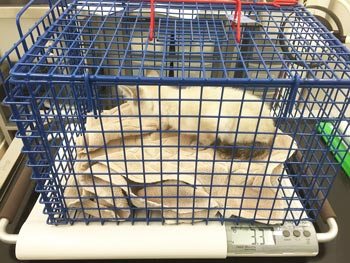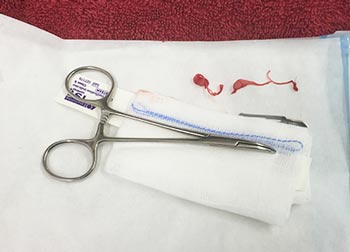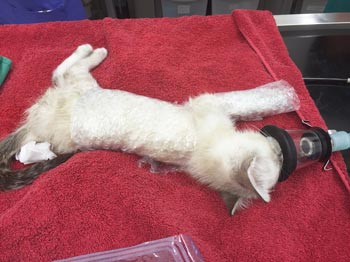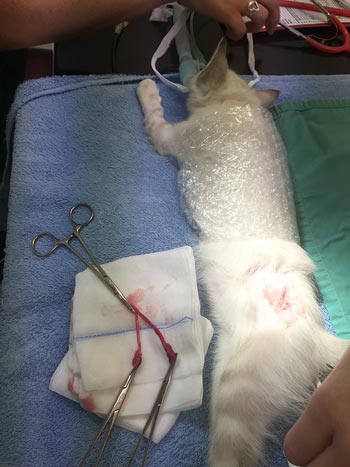19 Jun 2017
Vanessa Biggle begins the first in a series on how the profession can help reduce rehoming numbers by looking at neutering.

Figure 4. A patient under anaesthesia. Kittens require additional support to prevent hypothermia. In this case, additional towelling, heat pads and bubble wrap are used.
It’s no secret cat rehoming centres are full to bursting, but the veterinary profession can help reduce the rate of feline relinquishment through education and early intervention, before the pet-human bond is broken. A number of common causes of feline relinquishment exist, which will be investigated over a series of articles.

The UK cat population has reached crisis point. In June 2016, Blue Cross reported a 35% rise in the number of kittens taken in so far that year, compared to the same period in 2015. Unplanned pregnancies in owned animals clearly produces increased strain on rehoming facilities and can encourage using pets for profit where owners are able to sell the kittens.
Uncontrolled feral colonies can grow quickly, which can lead to increased spread of disease and decrease of available food and environment, affecting the colonies’ overall health. The increasing number may also be regarded as a nuisance.
RSPCA research has indicated the number of new homes rehoming cats has declined by 10%, although rehoming activity and efforts have not decreased. The market for adult cats is already small in comparison to kittens, and appears to be reaching saturation point. Effective neutering is widely regarded as the principal way to control the cat population and a number of charity-driven subsidised neutering schemes have occurred. Despite this, neutering rates have not increased in line to maintain a stable population, with 15% of females having had at least one litter, and it is important for charities and organisations to identify why this is, so the problem can be addressed correctly (RSPCA, 2014).
Several myths exist regarding neutering and cats – owners may simply be unaware of the reasons why they should get their cat neutered and financial barriers may exist for some.

It is important to understand the contributing factors beyond financial constraints to implement change. Studies have shown 92% of cats aged 6 months or older were neutered, but only 66% of cats between 6 and 12 months old were neutered. Interestingly, neutering of females was identified as the key factor to controlling population and the level of male cat castration was irrelevant (RSPCA, 2014). Of course, many other positive reasons exist to neuter males.
While cat ownership is consistent across all socio-economical groups, those in the lower three groups (C2DE) are twice as likely not to neuter as the three upper groups (ABC1). Getting a cat or kitten from friends or family whose cat has had a litter is strongly correlated with not neutering and those who do not neuter are likely to have friends and family who also do not neuter (RSPCA, 2014).
While the majority of society is comfortable with the concept of neutering, the myth of allowing one litter is widespread, with many owners applying human emotions on to their pets. Many will neuter after the first litter, although this is a significant number of 15% of females having one litter and, unfortunately, a significant number of these will go on to have further litters (RSPCA, 2014). Unfortunately, a lot of the issues raised by having entire male and female cats, and the associated problems with litters or antisocial behaviour, may increase the possibilities of these animals being abandoned or turned over to rescue.
Considerable confusion exists for owners in regards to when to neuter, which increases the chances of females getting pregnant. Once a cat has had a litter, confusion may result over when she becomes fertile and these cats may subsequently become pregnant again. Also, some owners do not realise they need to get their cat neutered or regard it as low priority.

The cost of neutering may be a genuine factor for some owners, while others may overestimate the cost. Research has shown, although awareness of subsidised neutering is high, understanding of how to progress through the scheme is low. Veterinary practice charges need to be taken into consideration in terms of the efficacy of neutering vouchers, as some practices will neuter at cost price and others will attempt to maximise profit. When issuing vouchers, responsibility is then passed to the owner to follow the scheme through.
Therefore, consideration needs to be given as to why owners do not go through with neutering, which may be related to inconvenience, transport, additional costs or veterinary practice factors. Following up to ensure the voucher has been used is beneficial, but addressing why people do not go through with the subsidised neutering and resolving this would be better.
Public, vet, council and Government education is key on many levels to reduce population through neutering and avoid other population control methods through euthanasia of healthy animals.
People frequently don’t realise they are contributing to the problem. Sometimes, they do not understand the issues that may occur from having entire cats – for example, injuries, disease spread and roaming. Because they cannot perceive a problem, no incentive exists for them to change their behaviour.
Improving the public‘s understanding of cats and their care is vital, whether through educational talks, social and broadcast media, helplines or event attendance. Neutering needs to be seen as the act of a responsible owner and the “one litter” myth must be tackled. Confusion over time of neutering needs to be resolved through education and promotion by rescues and veterinary practices.

Education of children regarding animal welfare can help influence future adults and pet owners. Despite efforts made by charities, animal welfare is not yet part of the national curriculum. Promoting the benefits of cat ownership and cats available in rescue can help to find good homes.
Another way to address the problem is continued promotion of the concept of neutering cats at four months of age (or before). Cats younger than six months old account for 14% of litters, with another 27% as the cat increases to a year old. Although this “early” neutering concept has been adopted widely by the US and a number of charities in the UK, it remains a less favourable solution for many vets due to perceived health concerns. However, numerous studies – up to 11 years post-procedure – have successfully refuted these concerns (Joyce and Yates, 2011).
Research has shown no negative impact of subsequent behaviour, growth or development (Joyce and Yates, 2011; RSPCA, 2014). In fact, positive effects were recorded in various studies. These included reduced occurrence of abscesses, urine spraying and aggression in early castrated males, and a 91% reduction in the risk of mammary carcinomas in females neutered before six months of age compared to intact females (Overley et al, 2005). The common concern of a link between prepubertal castration and FLUTD has been researched in several studies, which demonstrated a lack of correlation (Howe et al, 2000; Spain et al, 2004).
Paediatric physiology and its implications for kitten anaesthesia include limited cardiovascular compensation, higher relative tissue oxygen consumption and a higher body surface area to mass ratio, resulting in a higher risk of hypothermia under anaesthesia. Cardiac output is predominantly dependent on heart rate in paediatrics, owing to a higher proportion of non-contractile tissue and, hence, a predetermined stroke volume. Paediatric animals also have an immature sympathetic nervous system.
These factors affect the choice of anaesthetic protocol for paediatrics that have limited capacity to compensate for drug-induced bradycardia and are, therefore, likely to develop hypotension – particularly with α2-adrenoceptor agonists and opioids. Additionally, as tissue oxygen consumption is increased in paediatrics, it is recommended oxygen is provided throughout surgery, even if anaesthetic depth is adequate without inhalational gases. Other pharmacological considerations for paediatric anaesthesia include hypoalbuminaemia, which may enhance the effects of highly protein-bound drugs, such as propofol and diazepam, and immature hepatic enzyme systems, which may reduce the rate of drug metabolism.
Benzodiazepines stimulate appetite and their use during anaesthesia may promote feeding on recovery. This is particularly valuable in kittens in helping prevent hypoglycaemia and hypothermia. In spite of the apparent physiological disadvantage, evidence exists that kittens demonstrate fewer behavioural signs of pain and a faster return to normal behaviour post-neutering than adult cats, supporting the move towards programmes for kitten neutering (Bruniges at al, 2015).
A free Kitten Quad app is also available to allow for easy drug calculations. Usage of the protocol is off licence. While meloxicam is licensed for use in cats larger than 2kg and older than six weeks, usage in early neutering may also be off licence. While the “quad” can be reversed, it is not recommended to use atipamezole until half an hour after ketamine administration to avoid excitement.
Food should be withheld for no more than three to five hours before surgery to reduce the risk of hypoglycaemia and food offered as soon as possible after recovery. Further information on anaesthetic and surgical considerations can be found at www.felineupdate.co.uk
Anna Gales RVN, who works at an RSPCA unit routinely practicing early neutering, said: “At first, I was nervous monitoring the anaesthetics of young kittens. Now I feel confident and have found, in general, they are effective and stable anaesthetics. Mostly, though, I’ve been won over at how quickly they bounce back after their procedure – they are awake and eating very quickly, and are generally playing again a few hours after their surgery.
“Anecdotally, I have found the females are generally less painful than adult cats having the same surgery. I also love the fact we can rehome these cats already neutered, eliminating the risk of unwanted pregnancies and helping reduce the cat population problems we are facing.”

Increasing practice awareness of this concept is vital for it to become accepted and promoted routinely by vets as standard good practice timing, rather than early neutering. Continued education in the subject for vets through awareness of online CPD or visiting practices could increase compliance, help change the mindset of many surgeons and help convert the concept to a conventional approach.
All rehoming centres should ensure cats are neutered prior to rehoming, where possible. Early neutering before 16 weeks may be necessary in these situations. For feral cats, considering neutering at seven to eight weeks may be necessary. No data is available, but there is agreement neutering, vaccinations and homing should be separated, if possible, to minimise potential problems caused by stress (RSPCA, 2014). Situations will arise where this is not possible – for example, in shelters, charity medicine or non-compliant clients.
By working with other charities, councils and social housing, increased awareness can be achieved and changes implemented. Using social and local media to promote neutering schemes would certainly increase uptake. Veterinary practices have an important role to play in education.
Poor owner knowledge of feline reproduction is a major contributory factor in the rate of unplanned litters (Welsh et al, 2013). Greater emphasis on education and pre-booking of neutering could help to decrease this. Promotion of spay days, pro bono work and mobile clinics can further feline welfare. For charities, considering a policy where animals must be neutered to use their services may increase compliance.
Collaboration between animal organisations and housing associations through community outreach programmes can help target people less likely to neuter, areas of urban deprivation in big cities where people cannot afford neutering or where neutering is a low priority. Unneutered cats can be a nuisance, damaging homes or creating environmental health issues.
Therefore, a benefit exists for housing associations and councils to help tackle neutering at a local level.